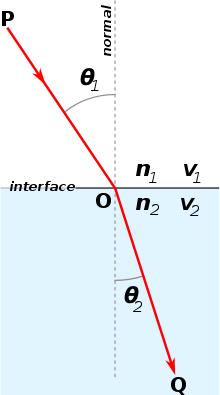Snell's law
Snell's law
Snell's law (also known as Snell–Descartes law and the law of refraction) is a formula used to describe the relationship between the angles of incidence and refraction, when referring to light or other waves passing through a boundary between two different isotropic media, such as water, glass, or air.
In optics, the law is used in ray tracing to compute the angles of incidence or refraction, and in experimental optics to find the refractive index of a material. The law is also satisfied in metamaterials, which allow light to be bent "backward" at a negative angle of refraction with a negative refractive index.
Snell's law states that the ratio of the sines of the angles of incidence and refraction is equivalent to the ratio of phase velocities in the two media, or equivalent to the reciprocal of the ratio of the indices of refraction:
- https://en.wikipedia.org/wiki/Snell%27s_law



ความคิดเห็น
แสดงความคิดเห็น